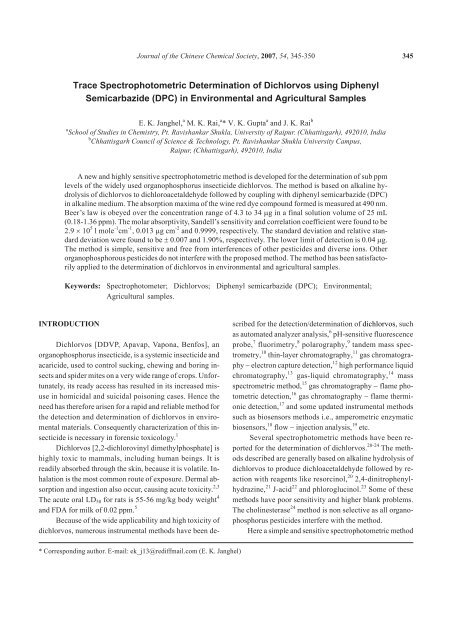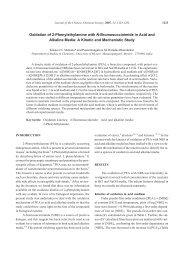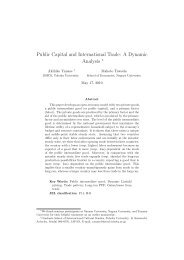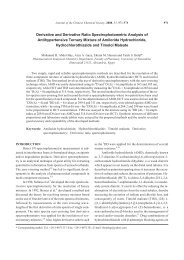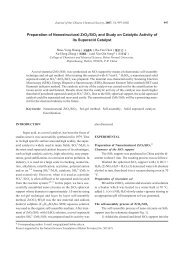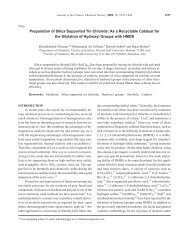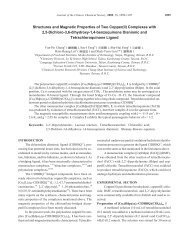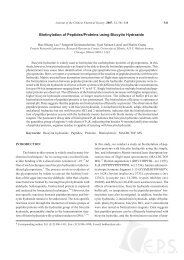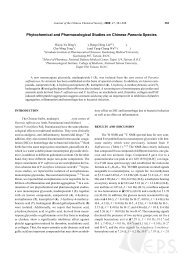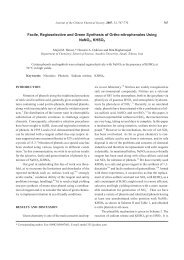Trace Spectrophotometric Determination of Dichlorvos using ...
Trace Spectrophotometric Determination of Dichlorvos using ...
Trace Spectrophotometric Determination of Dichlorvos using ...
Create successful ePaper yourself
Turn your PDF publications into a flip-book with our unique Google optimized e-Paper software.
Journal <strong>of</strong> the Chinese Chemical Society, 2007, 54, 345-350 345<br />
<strong>Trace</strong> <strong>Spectrophotometric</strong> <strong>Determination</strong> <strong>of</strong> <strong>Dichlorvos</strong> <strong>using</strong> Diphenyl<br />
Semicarbazide (DPC) in Environmental and Agricultural Samples<br />
E. K. Janghel, a M. K. Rai, a * V. K. Gupta a and J. K. Rai b<br />
a School <strong>of</strong> Studies in Chemistry, Pt. Ravishankar Shukla, University <strong>of</strong> Raipur. (Chhattisgarh), 492010, India<br />
b Chhattisgarh Council <strong>of</strong> Science & Technology, Pt. Ravishankar Shukla University Campus,<br />
Raipur, (Chhattisgarh), 492010, India<br />
A new and highly sensitive spectrophotometric method is developed for the determination <strong>of</strong> sub ppm<br />
levels <strong>of</strong> the widely used organophosphorus insecticide dichlorvos. The method is based on alkaline hydrolysis<br />
<strong>of</strong> dichlorvos to dichloroacetaldehyde followed by coupling with diphenyl semicarbazide (DPC)<br />
in alkaline medium. The absorption maxima <strong>of</strong> the wine red dye compound formed is measured at 490 nm.<br />
Beer’s law is obeyed over the concentration range <strong>of</strong> 4.3 to 34 g in a final solution volume <strong>of</strong> 25 mL<br />
(0.18-1.36 ppm). The molar absorptivity, Sandell’s sensitivity and correlation coefficient were found to be<br />
2.9 10 5 l mole -1 cm -1 , 0.013 g cm -2 and 0.9999, respectively. The standard deviation and relative standard<br />
deviation were found to be 0.007 and 1.90%, respectively. The lower limit <strong>of</strong> detection is 0.04 g.<br />
The method is simple, sensitive and free from interferences <strong>of</strong> other pesticides and diverse ions. Other<br />
organophosphorous pesticides do not interfere with the proposed method. The method has been satisfactorily<br />
applied to the determination <strong>of</strong> dichlorvos in environmental and agricultural samples.<br />
Keywords: Spectrophotometer; <strong>Dichlorvos</strong>; Diphenyl semicarbazide (DPC); Environmental;<br />
Agricultural samples.<br />
INTRODUCTION<br />
<strong>Dichlorvos</strong> [DDVP, Apavap, Vapona, Benfos], an<br />
organophosphorus insecticide, is a systemic insecticide and<br />
acaricide, used to control sucking, chewing and boring insects<br />
and spider mites on a very wide range <strong>of</strong> crops. Unfortunately,<br />
its ready access has resulted in its increased misuse<br />
in homicidal and suicidal poisoning cases. Hence the<br />
need has therefore arisen for a rapid and reliable method for<br />
the detection and determination <strong>of</strong> dichlorvos in enviromental<br />
materials. Consequently characterization <strong>of</strong> this insecticide<br />
is necessary in forensic toxicology. 1<br />
<strong>Dichlorvos</strong> [2,2-dichlorovinyl dimethylphosphate] is<br />
highly toxic to mammals, including human beings. It is<br />
readily absorbed through the skin, because it is volatile. Inhalation<br />
is the most common route <strong>of</strong> exposure. Dermal absorption<br />
and ingestion also occur, ca<strong>using</strong> acute toxicity. 2,3<br />
The acute oral LD 50 for rats is 55-56 mg/kg body weight 4<br />
and FDA for milk <strong>of</strong> 0.02 ppm. 5<br />
Because <strong>of</strong> the wide applicability and high toxicity <strong>of</strong><br />
dichlorvos, numerous instrumental methods have been described<br />
for the detection/determination <strong>of</strong> dichlorvos, such<br />
as automated analyzer analysis, 6 pH-sensitive fluorescence<br />
probe, 7 fluorimetry, 8 polarography, 9 tandem mass spectrometry,<br />
10 thin-layer chromatography, 11 gas chromatography<br />
electron capture detection, 12 high performance liquid<br />
chromatography, 13 gas-liquid chromatography, 14 mass<br />
spectrometric method, 15 gas chromatography flame photometric<br />
detection, 16 gas chromatography flame thermionic<br />
detection, 17 and some updated instrumental methods<br />
such as biosensors methods i.e., amperometric enzymatic<br />
biosensors, 18 flow injection analysis, 19 etc.<br />
Several spectrophotometric methods have been reported<br />
for the determination <strong>of</strong> dichlorvos. 20-24 The methods<br />
described are generally based on alkaline hydrolysis <strong>of</strong><br />
dichlorvos to produce dichloacetaldehyde followed by reaction<br />
with reagents like resorcinol, 20 2,4-dinitrophenylhydrazine,<br />
21 J-acid 22 and phloroglucinol. 23 Some <strong>of</strong> these<br />
methods have poor sensitivity and higher blank problems.<br />
The cholinesterase 24 method is non selective as all organophosphorus<br />
pesticides interfere with the method.<br />
Here a simple and sensitive spectrophotometric method<br />
* Corresponding author. E-mail: ek_j13@rediffmail.com (E. K. Janghel)
346 J. Chin. Chem. Soc., Vol. 54, No. 2, 2007 Janghel et al.<br />
Scheme I Proposed reaction for formation <strong>of</strong> coloured species<br />
The colour reaction involves the following steps.<br />
1. Hydrolysis <strong>of</strong> dichlorvos to its corresponding aldehyde.<br />
2. Coupling <strong>of</strong> aldehyde with DPC under alkaline conditions to form wine - reddish dye at 490 nm.<br />
is described for the determination <strong>of</strong> dichlorvos, where<br />
dichlorvos is hydrolysed to give dichloroacetaldehyde,<br />
which is further reacted with diphenyl semicarbazide (DPC)<br />
to produce a wine - reddish dye, with maximum absorbance<br />
at 490 nm (Scheme I). The reagent is selective and sensitive<br />
for dichlorvos, amongst the organophosphorus group. The<br />
colour system obeys Beer’s law in the range <strong>of</strong> 0.18-1.36<br />
ppm <strong>of</strong> dichlorvos. The method has been applied to the determination<br />
<strong>of</strong> dichlorvos in various samples <strong>of</strong> polluted<br />
water, vegetables, soil, foliage and environmental samples.<br />
The technique can be applied as a useful method for<br />
simple and rapid analysis. The features <strong>of</strong> the method are<br />
its sensitivity and stability <strong>of</strong> the colour formed. The results<br />
<strong>of</strong> trace <strong>of</strong> the target substance is not interfered with by the<br />
presence <strong>of</strong> other pesticides, especially other phosphorous<br />
pesticides.<br />
EXPERIMENTAL<br />
Apparatus<br />
A Systronics UV-Vis spectrophotometer model - 104<br />
with matched silica cells was used for all spectral measurements.<br />
A Systronic pH meter model - 335 was used for pH<br />
measurements. A Remi C-854/4 clinical centrifuge force <strong>of</strong><br />
1850 g with fixed swingout rotors was used for centrifuga-
<strong>Determination</strong> <strong>of</strong> <strong>Dichlorvos</strong> J. Chin. Chem. Soc., Vol. 54, No. 2, 2007 347<br />
tion.<br />
Reagents<br />
All reagents used were <strong>of</strong> Anala R grade or <strong>of</strong> the best<br />
available quality. Double distilled deionised water was<br />
used throughout.<br />
<strong>Dichlorvos</strong> (Hindustion Ciba-Geigy Bombay, India):<br />
A stock solution <strong>of</strong> 1 mg mL -1 was prepared in ethanol.<br />
Working standard solutions were prepared by appropriate<br />
dilution <strong>of</strong> the stock standard solution with ethanol.<br />
Sodium hydroxide: A 1.0 mol L -1 aqueous solution<br />
was used.<br />
Hydrochloric acid: A 0.001 mol L -1 aqueous solution<br />
was used.<br />
Diphenyl semicabazide (DPC) (E. Merck, Germany):<br />
0.05% (m/v) solution <strong>of</strong> the reagent was prepared by dissolving<br />
0.05 gm <strong>of</strong> diphenyl semicarbazide (DPC) in 100<br />
mL ethanol.<br />
Procedure<br />
An aliquot <strong>of</strong> the test solution containing 4.3 to 34 g<br />
<strong>of</strong> dichlorvos was taken in a 25 mL graduated tube and to it<br />
1.0 mL <strong>of</strong> 1.0 mol l -1 sodium hydroxide was added. The solution<br />
was kept for 30 min at room temperature for complete<br />
hydrolysis. Then 1 mL, 0.05% (m/v) <strong>of</strong> diphenyl semicarbazide<br />
(DPC) was added, shaken thoroughly, and the pH<br />
was adjusted to 9.0-9.3 by adding 0.001 mol l -1 hydrochloric<br />
acid. The solution was kept for 45 min for full colour<br />
development. A wine - reddish monomethine dye is obtained.<br />
25,26,27 The solution was then diluted to the mark with<br />
water and absorbance was measured at 490 nm against a reagent<br />
blank.<br />
RESULTS AND DISCUSSION<br />
Spectral characteristics<br />
The wine - reddish dye formed in the proposed reaction<br />
shows maximum absorption at 490 nm. All spectral<br />
measurements carried out against deionised water as the reagent<br />
blank showed negligible absorption at this wavelength.<br />
The colour system obeys Beer’s law in the range <strong>of</strong><br />
4.3 to 34 g <strong>of</strong> dichlorvos in 25 mL <strong>of</strong> final solution at 490<br />
nm. The molar absorptivity, Sandell’s sensitivity and correlation<br />
coefficient were found to be 2.9 10 5 l mol -1 cm -1 ,<br />
0.013 g and 0.9999 cm -2 , respectively.<br />
Optimization <strong>of</strong> conditions<br />
Hydrolysis <strong>of</strong> dichlorvos to dichloroacetaldehyde<br />
was studied at different temperatures and alkalinity. It was<br />
observed that alkaline conditions were required for the hydrolysis.<br />
Maximum hydrolysis was observed with 1.0 mol<br />
l -1 sodium hydroxide at a temperature <strong>of</strong> 20-25 C as it gave<br />
maximum absorbance values, good stability and quantitative<br />
results. It was observed that 1 mL <strong>of</strong> diphenyl semicarbazide<br />
(DPC) was sufficient for complete colour reaction.<br />
Effect <strong>of</strong> time and temperature<br />
The effect <strong>of</strong> pH on the colour reaction was studied,<br />
and it was found that constant absorbance values were obtained<br />
at a pH range <strong>of</strong> ~ 9.0-9.3, and no buffer solution<br />
was required to stabilize the colour. At pH lower and higher<br />
than this, absorbance values decreased. It was found that 45<br />
min was required for full colour development; the colour<br />
was stable for several days. The maximum absorbance <strong>of</strong><br />
the dye was obtained at 25 C. At higher temperatures the<br />
absorbance value decreased (Table 1).<br />
Precision <strong>of</strong> the method was checked by the replicate<br />
analysis <strong>of</strong> working standard solution containing 5 gmL -1<br />
<strong>of</strong> dichlorvos in 25 mL final solution over a period <strong>of</strong> 7<br />
days. The standard deviation and relative standard deviation<br />
were found to be 0.007 and 1.90% respectively.<br />
Effect <strong>of</strong> foreign species<br />
The effect <strong>of</strong> common foreign species and pesticides<br />
were studied to assess the validity <strong>of</strong> the method. Known<br />
amounts <strong>of</strong> foreign species and pesticides were added to the<br />
standard solution containing 5 g <strong>of</strong> dichlorvos prior to hydrolysis,<br />
and the solution was analysed by the proposed<br />
method. The method was found to be free from interfer-<br />
Table 1. Effect <strong>of</strong> temperature on colour reaction (Concentration<br />
<strong>of</strong> dichlorvos, 0.2 ppm)<br />
Temperature C<br />
Absorbance*, 490 nm<br />
5 0.320<br />
10 0.412<br />
15 0.445<br />
20 0.448<br />
25 0.450<br />
30 0.440<br />
35 0.341<br />
40 0.286<br />
* Mean <strong>of</strong> three replicate values.
348 J. Chin. Chem. Soc., Vol. 54, No. 2, 2007 Janghel et al.<br />
ences <strong>of</strong> most <strong>of</strong> the foreign species and pesticides (Table<br />
2).<br />
<strong>Determination</strong> <strong>of</strong> dichlorvos in water<br />
River water samples, receiving run-<strong>of</strong>f water from<br />
agricultural fields sprayed with dichlovos, were collected.<br />
These samples were extracted with 2 25 mL portions <strong>of</strong><br />
diethyl ether. The ether solution was evaporated to dryness,<br />
and the residue was dissolved in 50 mL <strong>of</strong> ethanol. Aliquots<br />
were then analysed as described above and in parallel by a<br />
reported method (Table 3).<br />
<strong>Determination</strong> <strong>of</strong> dichlorvos in soil and vegetables<br />
Various samples such as soil, cauliflower and tomatoes<br />
were collected from the fields were dichlorvos was<br />
used as an insecticide. The samples where weighed (50 g),<br />
crushed and extracted with 2 25 mL portions <strong>of</strong> diethyl<br />
ether. Diethyl ether was then evaporated to dryness, and the<br />
residue was dissolved in 50 mL <strong>of</strong> ethanol. Aliquots were<br />
then analysed as described above and in parallel by a reported<br />
method (Table 3).<br />
Application<br />
The proposed method has been applied satisfactorily<br />
to the determination <strong>of</strong> dichlorvos in various samples <strong>of</strong><br />
water, vegetables, and soil. The results are in good agreement<br />
with the reported method. To check the recoveries,<br />
known amounts <strong>of</strong> dichlorvos were added to these samples<br />
and then analysed by the proposed as well as the reported<br />
method (Table 3). The recoveries were found to be 88 to<br />
Table 2. Effect <strong>of</strong> various pecticides and pollutants (Concentration <strong>of</strong> dichlorvos, 0.2 ppm)<br />
Foreign species<br />
Tolerance limit*<br />
ppm<br />
Foreign species<br />
BHC, DDT 600<br />
--<br />
SO 4<br />
Benzene, Ether 500<br />
--<br />
CO 3<br />
Malathion 400<br />
-<br />
NO 2<br />
2:4-D, 2:4:5-T 350<br />
--<br />
NO 3<br />
Tolerance limit*<br />
ppm<br />
450<br />
300<br />
150<br />
100<br />
Cyanide 200 Cu 2+ ,Pb 2+ 60<br />
Kelthane, Fluoride, Sb 3+ , 50<br />
100<br />
Chlor<strong>of</strong>orm<br />
Ca 2+ ,Mg 2+ ,Cd 2+ 40<br />
Parathion 50 K + ,Cl - 30<br />
* The amount ca<strong>using</strong> an error <strong>of</strong> 2% in absorbance value.<br />
Table 3. <strong>Determination</strong> <strong>of</strong> dichlorvos in various environmental and agricultural samples<br />
Sample<br />
<strong>Dichlorvos</strong> originally found*<br />
Proposed<br />
method<br />
(g)<br />
(a)<br />
Agricultural 5.98<br />
waste water a 4.63<br />
Soil b 4.80<br />
4.98<br />
Cauliflower c 5.14<br />
5.46<br />
Tomatoes d 6.76<br />
4.32<br />
Reported<br />
method 23<br />
(g)<br />
5.98<br />
3.02<br />
2.82<br />
4.86<br />
3.28<br />
5.12<br />
6.51<br />
3.58<br />
<strong>Dichlorvos</strong> added<br />
(g )<br />
(b)<br />
10<br />
20<br />
10<br />
20<br />
10<br />
20<br />
10<br />
20<br />
Total dichlorvos<br />
found by<br />
proposed*<br />
method<br />
(c)<br />
15.862<br />
23.828<br />
13.664<br />
24.496<br />
14.329<br />
25.235<br />
16.734<br />
23.466<br />
Difference<br />
(c-a)<br />
9.88<br />
19.19<br />
8.86<br />
19.51<br />
9.18<br />
19.77<br />
9.97<br />
19.14<br />
Recovery<br />
%<br />
(c-a)<br />
b<br />
98.8<br />
95.9<br />
88.6<br />
97.6<br />
91.8<br />
98.9<br />
99.7<br />
95.7<br />
* Mean <strong>of</strong> five replicate analysis.<br />
a = Water sample 250 mL, after treatment 1 mL aliquot was analysed.<br />
b, c and d = Sample 50 gm (taken from an agriculture field, 1 mL aliquot <strong>of</strong> sample was analysed after treatment as described<br />
in the procedure section)<br />
100
<strong>Determination</strong> <strong>of</strong> <strong>Dichlorvos</strong> J. Chin. Chem. Soc., Vol. 54, No. 2, 2007 349<br />
Table 4. Comparison with other reported reagents<br />
Reagent<br />
max<br />
(nm)<br />
Beer’s law range<br />
(ppm)<br />
Remarks<br />
Resorcinol 20 490 1-20 Dye unstable, high reagent blank<br />
2,4-dinitrophenyl hydrazine 21 580 3.4-27.5 Less sensitive<br />
Chlolinesterase 22 412 20 Interference <strong>of</strong> other organophosphorus pesticides<br />
J-acid 23 470 1-10 Less sensitive<br />
Phloroglucinol 24 475 0.4-4 Less sensitive<br />
Diphenyl semicarbazide (DPC)<br />
(present method)<br />
490 0.18-1.36 High sensitivity<br />
99%.<br />
CONCLUSION<br />
The proposed method has been compared with other<br />
spectrophotometric methods and found to be more sensitive<br />
and selective (Table 4). This method is a good alternative<br />
to some <strong>of</strong> the reported costly instrument methods. 28<br />
The advantage <strong>of</strong> the proposed method is mainly its sensitivity,<br />
simplicity and selectivity and higher stability <strong>of</strong> the<br />
coloured solution. The proposed method has been successfully<br />
applied for the determination <strong>of</strong> dichlorvos in water,<br />
soil and vegetables.<br />
ACKNOWLEDGEMENTS<br />
Authors are thankful to the Head School <strong>of</strong> Studies in<br />
Chemistry, Pt. Ravishankar Shukla University, Raipur, and<br />
the Director General, Chhattisgarh Council <strong>of</strong> Science &<br />
Technology for providing laboratory and grant facilities.<br />
One <strong>of</strong> them, V. K. Gupta is thankful to A.I.C.T.E, New<br />
Delhi for the award <strong>of</strong> an Emeritus Fellowship.<br />
Received March 10, 2006.<br />
REFERENCES<br />
1. Zweig, Z. Analytical Methods for Pesticides and Plant<br />
Growth Regulators; Academic Press: New York, 1964; p<br />
561.<br />
2. Gallo, M. A.; Lawryk, J. L. Organic Phosphorous Pesticides.InHandbook<br />
<strong>of</strong> Pesticide Toxicology; Hayes, W. J. Jr.,<br />
Laws, E. R. Jr., Eds.; Academic Press: New York, 1991; p 5.<br />
3. U. S. Public Health Service, Hazardous Substance Data<br />
Bank, Washington D. C, 1995.<br />
4. The American Conference <strong>of</strong> Governmental Industrial<br />
Hygenists (ACGIH), 1994, 19.<br />
5. Asfahl, C. R. Industrial Safety and Health Management;<br />
Prentice Hall, Inglewood Clifffs: New Jersey, 1990.<br />
6. Ludwicki, J.; Rocz P.; Zakl, H. 1983, 34, 289.<br />
7. Shengye, J.; Zhaochao, X.; Jiping, C.; Xinmiao, L.; Yongning,<br />
W.; Xuhong, Q. Anal. Chim. Acta 2004, 523, 117.<br />
8. Poziomek, E. J.; Crabtree, E. V.; Mullin, J. W. Anal. Lett.<br />
Part A 1981, 14, 825.<br />
9. Davidek, J.; Joseff, S.; Zolena, D. Milchwissenschaf 1976,<br />
31, 267.<br />
10. Nakazawa, H.; Takahashi, N.; Inoue, K.; Ito, Y.; Goto, T.;<br />
Kato, K.; Yoshimura, Y.; Oka, H. Talanta 2004, 64, 899.<br />
11. Vitthal, B. P.; Murlidhar, S. S. Talanta 1994, 41, 367.<br />
12. Cengiz, M. F.; Certel, M.; Gocmen, H. Food Chem. 2006,<br />
98, 127.<br />
13. Huang, G.; Ouyang, J.; Willy, R. G.; Baeyens, Y. Y.; Tao, C.<br />
Anal. Chim. Acta 2002, 474, 21.<br />
14. Minett, W.; Belcher, R. S. J. Stored Products Research 1969,<br />
5, 417.<br />
15. Wiltshire, H.; Wiltshire, B.; Citron, A.; Clarke, T.; Serpe, C.;<br />
Gray, D.; Herron, W. J. Chromatogr. B 2000, 745, 373.<br />
16. Bai, Y.; Zhou, L.; Wang, J. Food Chem. 2006, 98, 240.<br />
17. Lambropoulou, D. A.; Albanis, T. A. J. Chromatogr. A 2005,<br />
1072, 55.<br />
18. Vidal, J. C.; Esteban, S.; Gil, J.; Castillo, J. R. Talanta 2006,<br />
68, 791.<br />
19. Shi, M.; Xu, J.; Zhang, S.; Liu, B.; Kong, J. Talanta 2006,<br />
68, 1089.<br />
20. Rangaswamy, J. R.; Muthu, M. Mikrochim. Acta 1984, 3,<br />
433.<br />
21. Hughes, J. T. Analyst 1963, 88, 318.<br />
22. Shivhare, P.; Gupta, V. K. J. Ind. Chem. Soc. 1991, 68, 287.<br />
23. Asthana, A.; Gupta, V. K. Ind. J. Chem. Tech. 2003, 10, 76.<br />
24. Drevenrkar, V.; Vasilic, Z.; Stefance, Z. Microchim. Acta
350 J. Chin. Chem. Soc., Vol. 54, No. 2, 2007 Janghel et al.<br />
1981, 2, 45.<br />
25. Anger, V.; Ofri, S, Z. Anal. Chem. 1964, 64, 203.<br />
26. Feigl, F. Spot Tests in Organic Analysis; Elsevier Scientific<br />
Publishing Company: New York, 1966.<br />
27. Christion, G. D. Analytical Chemistry; John Wiley and Sons:<br />
New York, 1986.<br />
28. Feigenbrugel, V.; Loew, C.; Calve, S. L.; Mirabel, P. J.<br />
Photochem. & Phtotobio. A: Chem. 2005, 174, 76.


